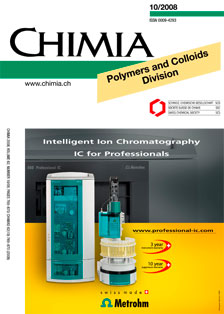Exfoliation of Sheet Silicates by Nitroxide Mediated Polymerization
DOI:
https://doi.org/10.2533/chimia.2008.799Keywords:
Alkoxyamines, Controlled/living radical polymerization, Exfoliation, Layered silicates, NanocompositesAbstract
A new cationic alkoxyamine initiator/regulator for the nitroxide-mediated polymerization of acrylates was prepared and intercalated by cation exchange into a montmorillonite-type natural and a synthetic layered silicate. Thermal activation of this alkoxyamine in the presence of n-butyl acrylate as monomer initiated its controlled radical polymerization, leading to an almost complete exfoliation of the silicate layers. The poly(n-butyl-acrylate) chains attached to the individual sheet silicate layers showed adjustable number average molecular weights (Mn) values between 1000 and 14000 g/mol and polydispersities PD (= Mw/Mn; Mw = weight average molecular weight) as low as 1.5. The poly(n-butyl acrylate) modified silicate nanoparticles obtained by this process have a polymer content between 41 and 89 wt.%, are non-agglomerated and stable in dispersion for >1 year without any sedimentation. They are easily re-dispersible in apolar solvents, in monomers and macromonomers which are used e.g. in coating formulations and in polymer solutions/melts, forming nanocomposites with novel properties. For example, a 20% reduction of the O2 permeability of polyethylene films was observed at 5 wt% loading with the exfoliated sheet silicate.Downloads
Published
2008-10-29
Issue
Section
Scientific Articles
License
Copyright (c) 2008 Swiss Chemical Society

This work is licensed under a Creative Commons Attribution-NonCommercial 4.0 International License.
How to Cite
[1]
A. Mühlebach, P. Nesvadba, F. Rime, L. Bugnon, Chimia 2008, 62, 799, DOI: 10.2533/chimia.2008.799.







